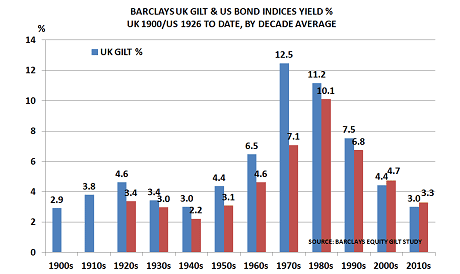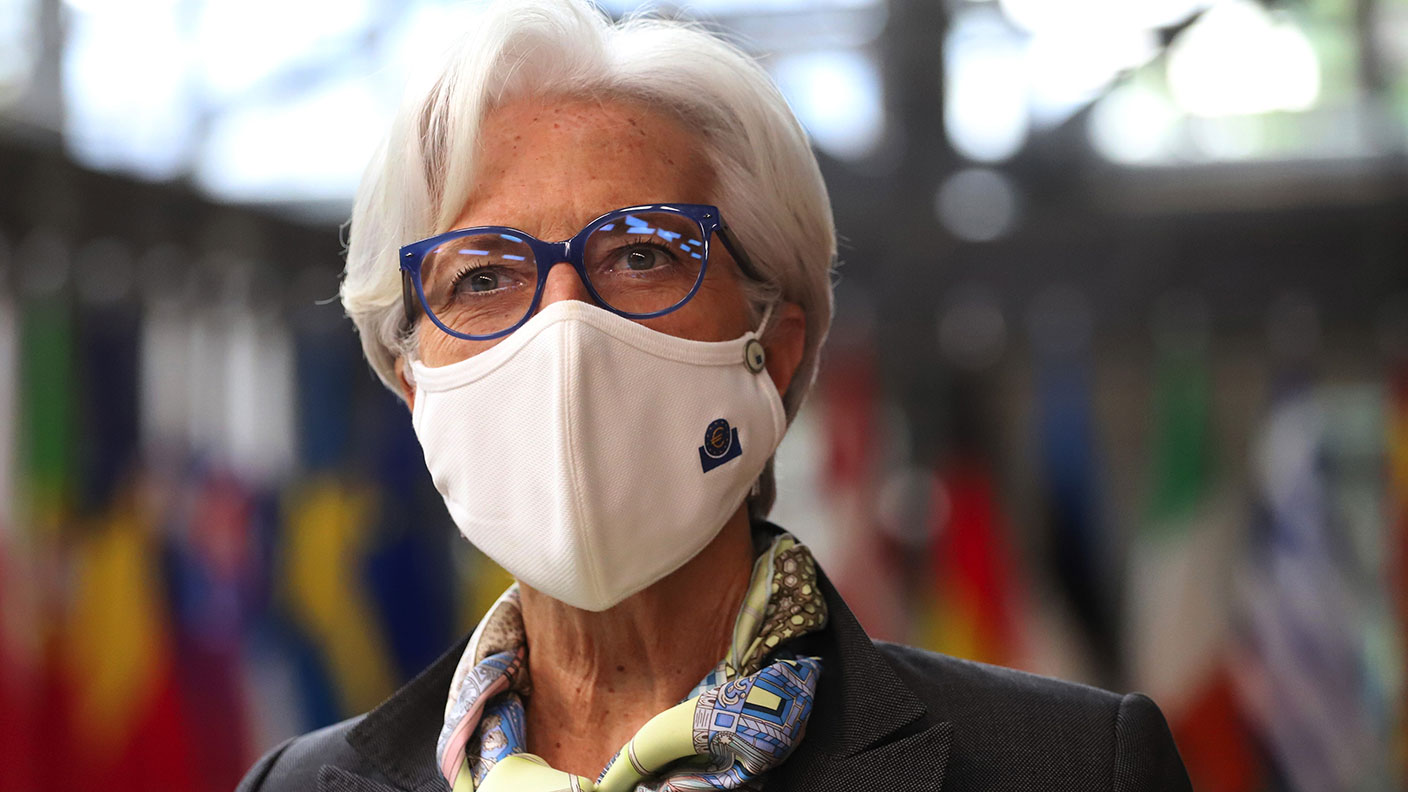Had it with low bond yields? Blame the baby boomers
Now the 'baby boomer super-cycle' is over, the rush for pension and retirement safety is pushing bond prices up, says Merryn Somerset Webb.

Are US and UK sovereign bonds in a bubble? With the US ten-year Treasuries yielding a mere 1.45% and UK ten-year gilts on 1.49%, the obvious answer - and the one we usually give - is yes.
Their prices, thanks to a mixture of safe haven demand, non-stop quantitative easing (via which all excess supply is hoovered up by central banks) and financial repression, are far too high, and will at some point fall fast. That might not happen this year or next year, but it will happen. The ropey finances of the two countries makes it all but a given.
However, there is a another way of looking at this. What if bond yields have simply reverted to the mean (as most things do) and have seen a temporary over shoot? Paul Hodges of International eChem has drawn my attention to the chart below (it is based on data from the annual Barclays Equity Gilt Study).
MoneyWeek
Subscribe to MoneyWeek today and get your first six magazine issues absolutely FREE

Sign up to Money Morning
Don't miss the latest investment and personal finances news, market analysis, plus money-saving tips with our free twice-daily newsletter
Don't miss the latest investment and personal finances news, market analysis, plus money-saving tips with our free twice-daily newsletter

What it shows us is that UK yields (blue) averaged 3.7% from 1900 to 1949 and have averaged 4.2% since 2000. Similarly, US yields averaged 2.7% between 1926 and 49 (no records before that) and 4.5% since 2000. "This would suggest it was the peak in the middle, between the 1970s-90s when yields averaged more like 8-10% - that was the exception rather than the rule," says Paul.
Paul has an explanation for this. It is, he says, all about the fact that the baby boomer super-cycle is over. I've looked at the effect that might have on growth in the past here: Bad news for growth: the baby-boomer super-cycle is over. But the point here is that the baby boomer rush for pension and retirement safety is another factor pushing bond prices up (and yields down).
It's a nice idea, and there is probably a good deal of truth in the idea that falling yields are in part connected to demography. However, it doesn't really change our current view about sovereign bonds.
Even if you assume the huge fall in yields from the highs of the 70s and 80s have had an element of mean reversion in them, and that they should be knocking around 3% - at well under 2% they have clearly gone too far in the other direction for long term investors to feel safe holding them.
Look at some more of the data from the Equity Gilt Study and you will see that investors who bought gilts at their last peak (in 1946) did not break even on their investment in real terms for 47 years. More on this here.
Get the latest financial news, insights and expert analysis from our award-winning MoneyWeek team, to help you understand what really matters when it comes to your finances.
Merryn Somerset Webb started her career in Tokyo at public broadcaster NHK before becoming a Japanese equity broker at what was then Warburgs. She went on to work at SBC and UBS without moving from her desk in Kamiyacho (it was the age of mergers).
After five years in Japan she returned to work in the UK at Paribas. This soon became BNP Paribas. Again, no desk move was required. On leaving the City, Merryn helped The Week magazine with its City pages before becoming the launch editor of MoneyWeek in 2000 and taking on columns first in the Sunday Times and then in 2009 in the Financial Times
Twenty years on, MoneyWeek is the best-selling financial magazine in the UK. Merryn was its Editor in Chief until 2022. She is now a senior columnist at Bloomberg and host of the Merryn Talks Money podcast - but still writes for Moneyweek monthly.
Merryn is also is a non executive director of two investment trusts – BlackRock Throgmorton, and the Murray Income Investment Trust.
-
 Halifax: UK house prices at lowest level since summer as growth slows
Halifax: UK house prices at lowest level since summer as growth slowsProperty prices fell by 0.6% month-on-month in a typical Christmas season slowdown, Halifax’s latest house price index shows.
-
 In the money: how my trading tips fared in 2025
In the money: how my trading tips fared in 2025The success of the open positions offset losses on closed ones, says Matthew Partridge
-
 Beating inflation takes more luck than skill – but are we about to get lucky?
Beating inflation takes more luck than skill – but are we about to get lucky?Opinion The US Federal Reserve managed to beat inflation in the 1980s. But much of that was down to pure luck. Thankfully, says Merryn Somerset Webb, the Bank of England may be about to get lucky.
-
 Rishi Sunak can’t fix all our problems – so why try?
Rishi Sunak can’t fix all our problems – so why try?Opinion Rishi Sunak’s Spring Statement is an attempt to plaster over problems the chancellor can’t fix. So should he even bother trying, asks Merryn Somerset Webb?
-
 Young people are becoming a scarce resource – we should value them more highly
Young people are becoming a scarce resource – we should value them more highlyOpinion In the last two years adults have been bizarrely unkind to children and young people. That doesn’t bode well for the future, says Merryn Somerset Webb.
-
 Ask for a pay rise – everyone else is
Ask for a pay rise – everyone else isOpinion As inflation bites and the labour market remains tight, many of the nation's employees are asking for a pay rise. Merryn Somerset Webb explains why you should do that too.
-
 Why central banks should stick to controlling inflation
Why central banks should stick to controlling inflationOpinion The world’s central bankers are stepping out of their traditional roles and becoming much more political. That’s a mistake, says Merryn Somerset Webb.
-
 How St Ives became St Tropez as the recovery drives prices sky high
How St Ives became St Tropez as the recovery drives prices sky highOpinion Merryn Somerset Webb finds herself at the epicentre of Britain’s V-shaped recovery as pent-up demand flows straight into Cornwall’s restaurants and beaches.
-
 The real problem of Universal Basic Income (UBI)
The real problem of Universal Basic Income (UBI)Merryn's Blog April employment numbers showed 75 per cent fewer people in the US returned to employment compared to expectations. Merryn Somerset-Webb explains how excessive government support is causing a shortage of labour.
-
 Why an ageing population is not necessarily the disaster many people think it is
Why an ageing population is not necessarily the disaster many people think it isOpinion We’ve got used to the idea that an ageing population is a bad thing. But that’s not necessarily true, says Merryn Somerset Webb.
